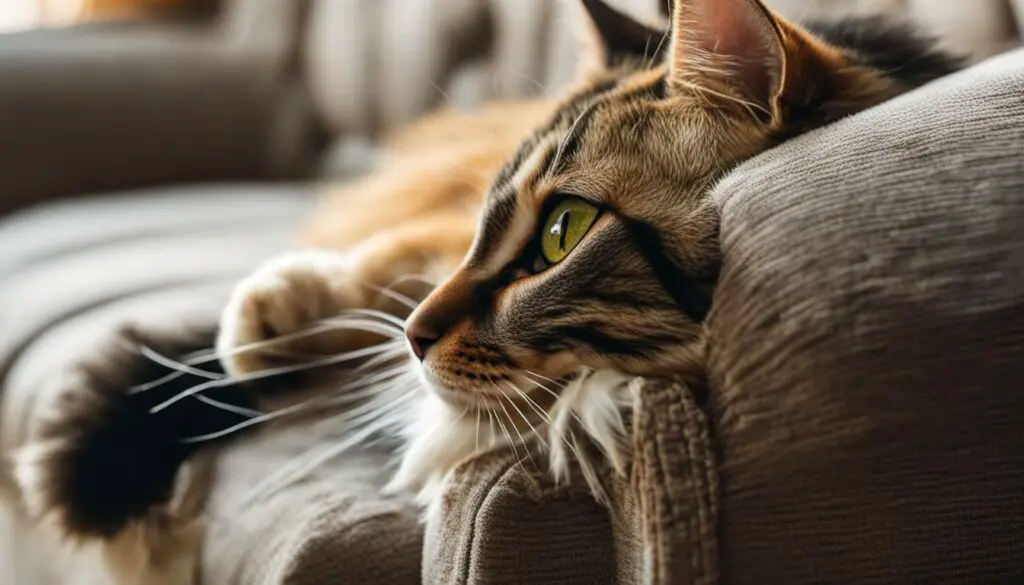Cats have a natural instinct to scratch, but when your pet cat uses you as a scratching post, it can be concerning and painful. Understanding the reasons behind this behavior can help you address and redirect it appropriately.
Key Takeaways:
- Scratching is a natural instinct for cats.
- Your cat may be using you as a scratching post to mark territory or relieve stress.
- Training, nail trimming, and providing alternative scratching surfaces can help redirect the behavior.
- Mental stimulation and understanding the importance of claws are crucial for promoting healthy scratching behavior.
- Declawing is not recommended, and exploring alternatives is essential for your cat’s well-being.
The Instinct to Mark Territory
Cats possess a natural instinct to mark their territory, and one way they do this is through scratching. They have scent glands in their paws, allowing them to leave their unique scent on surfaces they scratch. So, when your cat uses you as a scratching post, it may be their way of claiming you as their property and communicating their boundaries to other animals.
The act of scratching on you can be seen as a form of feline declaration, with your body serving as a convenient and easily accessible surface for them to leave their scent. By scratching on you, cats are not only marking their territory but also asserting their dominance. It’s important to understand that this behavior is rooted in their instinctual need to establish their place in their environment and communicate with other animals.
The Instinct to Mark Territory
To better understand this behavior, let’s take a look at some key factors:
- Cat territorial behavior: Scratching on you allows cats to leave their scent and mark their territory.
- Cat scent glands: Cats have scent glands in their paws, which enables them to leave their unique scent on surfaces they scratch.
- Marking territory: Scratching on you serves as a way for cats to claim you as their property and communicate their boundaries to other animals.
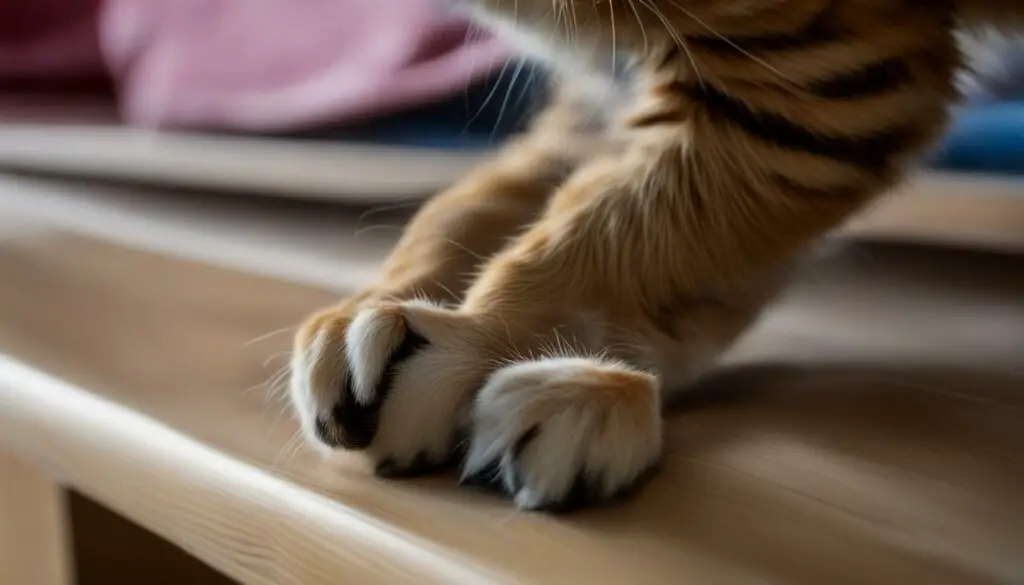
Understanding the Instinct
It’s important to recognize that this behavior is instinctual for cats and not a personal attack on you. While it may be painful or bothersome, redirecting their scratching behavior to appropriate surfaces can help mitigate this issue. Providing your cat with a scratching post or cat tree and regularly trimming their claws can help satisfy their natural desire to scratch and protect your skin from scratches.
Remember, your cat isn’t intentionally trying to harm you when they use you as a scratching post. By understanding their instincts and providing them with suitable alternatives, you can create a harmonious environment for both you and your feline companion.
The Role of Stress and Anxiety in Your Cat’s Scratching Behavior
Stress and anxiety can play a significant role in your cat’s decision to use you as a scratching post. Changes in the home environment, such as the introduction of a new pet or a baby, can trigger these emotions in cats. When they feel uneasy or overwhelmed, scratching on you can provide them with a sense of comfort and security.
It’s important to pay attention to your cat’s behavior and look for signs of stress or anxiety. Excessive grooming, hiding, aggression, or changes in appetite can all indicate that your cat is experiencing emotional distress. By addressing the underlying causes of stress and anxiety, you can help alleviate your cat’s need to scratch on you.
Creating a calm and peaceful environment for your cat is crucial. Establish a consistent routine and provide them with a designated safe space where they can retreat when they feel overwhelmed. Additionally, engaging in regular playtime and providing interactive toys can help reduce anxiety and redirect their scratching behavior.
Redirecting the Behavior
When your cat starts using you as a scratching post, it’s important to redirect their behavior to prevent any injuries and discomfort. Here are some effective strategies for training your cat not to scratch you:
Training and Consistency
Consistency is key when it comes to training your cat. Whenever your cat starts scratching on you, firmly say “No. Get down” and gently remove them from your body. It’s important to remain calm and patient throughout the training process. Repeat this training every time your cat exhibits the undesired behavior.
To reinforce positive behavior, reward your cat with praise and treats when they use an appropriate scratching surface. This will help them associate the scratching post or designated scratching area with positive reinforcement.
Providing Alternative Scratching Surfaces
One effective way to redirect your cat’s scratching behavior is to provide them with alternative surfaces. Invest in a high-quality scratching post or cat tree and place it near areas where your cat frequently scratches on you. The scratching post should be sturdy and tall enough for your cat to fully stretch their body while scratching. Add catnip or toys to make the scratching post more enticing.
Additionally, you can use double-sided tape or aluminum foil to deter your cat from scratching on furniture or other surfaces that they shouldn’t scratch. Cats usually dislike the sticky feeling of tape or the sound and texture of foil, which can help redirect their scratching behavior to more appropriate surfaces.
Trimming Your Cat’s Claws
Regularly trimming your cat’s claws can help prevent them from scratching you accidentally. Use pet-friendly nail clippers and be cautious not to cut too close to the quick, which can cause bleeding and pain. If you’re unsure about how to trim your cat’s claws, consult with a veterinarian or a professional groomer for guidance.
Remember, redirecting your cat’s scratching behavior requires patience and consistency. By implementing these strategies and providing your cat with appropriate alternatives, you can help them develop healthy scratching habits and enjoy a scratch-free and harmonious relationship with your feline friend.
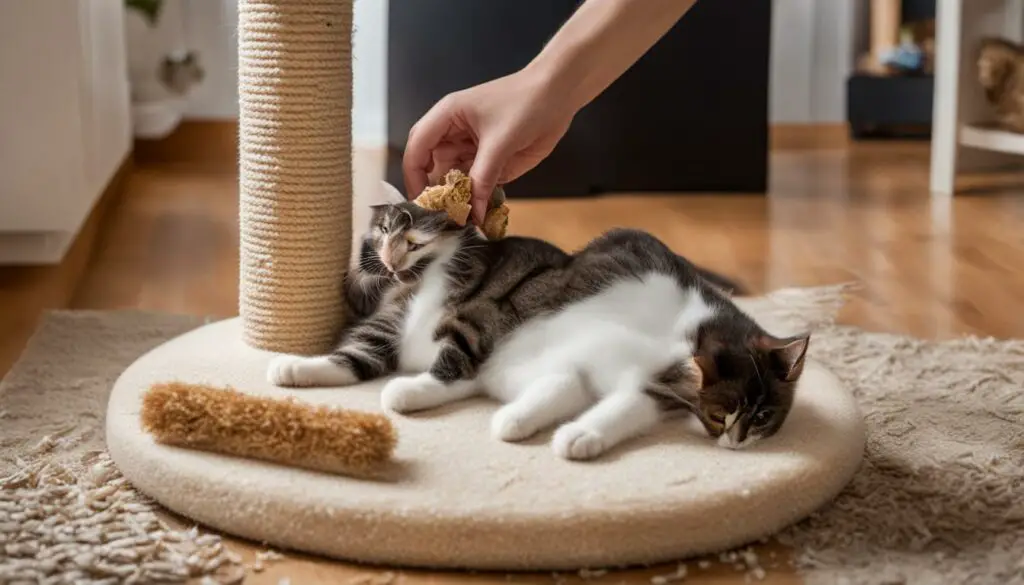
Trimming Claws
Trimming your cat’s claws is an important part of their grooming routine and can help prevent them from scratching you. Regular nail maintenance ensures that their claws remain at a manageable length and reduces the risk of accidental scratches. While it may seem daunting at first, with patience and the right approach, you can successfully trim your cat’s claws at home.
Before you begin, it’s essential to gather the necessary supplies. You’ll need a pair of cat nail clippers or human nail clippers with a straight edge, styptic powder or cornstarch to stop any bleeding, and treats or rewards to offer your cat as a positive reinforcement. It’s important to start the nail trimming session when your cat is calm and relaxed, such as after a meal or a play session.
To trim your cat’s claws, gently hold their paw and press their pad to extend the claws. Carefully clip off the transparent tip of each claw, being careful to avoid cutting the quick, which is the pink area that contains blood vessels. If you accidentally cut the quick and bleeding occurs, apply styptic powder or cornstarch to stop the bleeding. Remember to reward your cat with treats and praise after each successful nail trimming session to reinforce positive behavior.
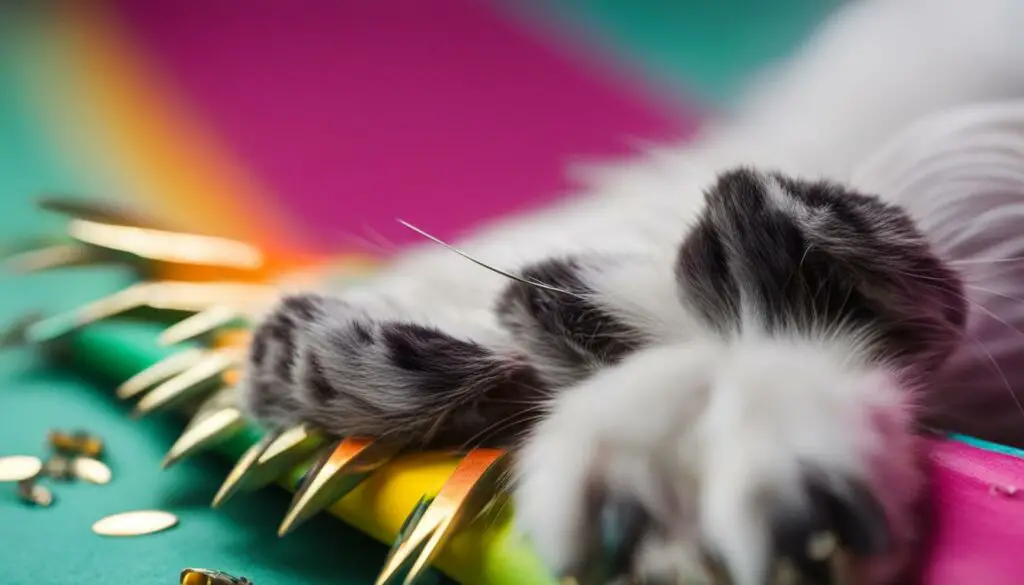
Regular nail trimming not only protects you from scratches but also helps maintain your cat’s overall health. It prevents the nails from becoming overgrown and curling into the paw pads, which can cause pain, infection, and mobility issues. By incorporating nail trimming into your cat’s grooming routine and providing them with alternative scratching surfaces, you can create a harmonious environment where both you and your cat can coexist happily.
Providing Alternative Scratching Surfaces
When your cat uses you as a scratching post, it’s important to redirect their behavior and provide them with alternative surfaces to scratch. Investing in a cat tree or scratching post can give your feline friend a designated area to exercise their natural instincts. Place the scratching post near areas where your cat frequently scratches on you to effectively redirect their scratching behavior.
In addition to a scratching post, there are other alternative scratching surfaces you can consider. Some cats prefer horizontal scratching, so providing a horizontal scratching pad or mat can be beneficial. These mats are usually covered with sisal or carpet, offering your cat a satisfying texture to scratch on.
Another option is a cardboard scratcher, which is inexpensive and readily available. Cats are often attracted to the texture and the ability to sink their claws into the cardboard. They can also serve as a temporary solution while you find a more permanent scratching surface that your cat enjoys.
Remember, when introducing a new scratching surface, make it more enticing for your cat. Rubbing catnip on the surface or attaching toys can help attract their attention. Reward your cat with praise or treats when they use the alternative scratching surface to reinforce the desired behavior.
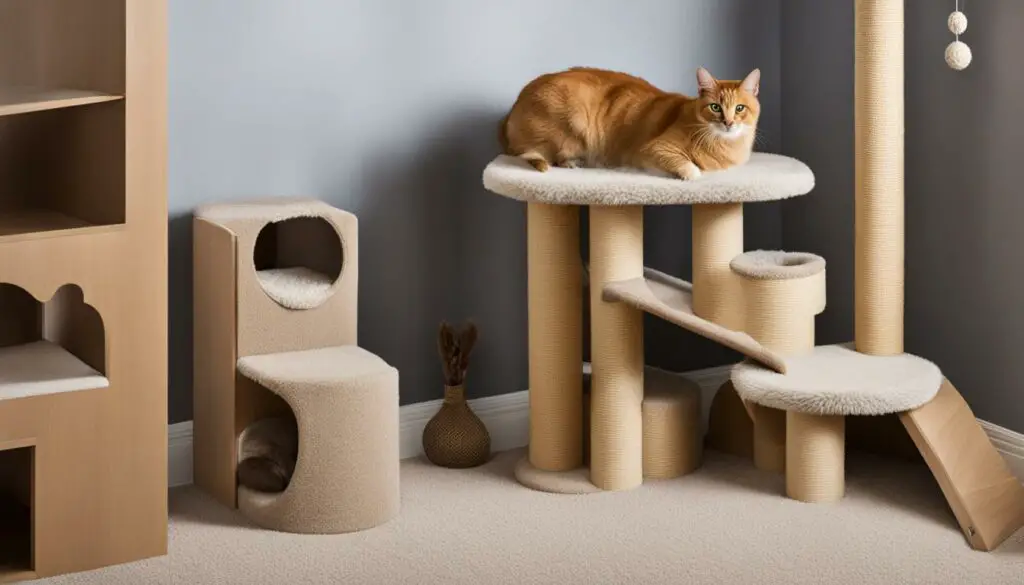
Key Points:
- Invest in a cat tree or scratching post to provide a designated scratching area
- Consider horizontal scratching pads or mats for cats that prefer to scratch horizontally
- Cardboard scratchers can serve as a temporary alternative scratching surface
- Make the alternative scratching surfaces enticing with catnip or toys
- Reward your cat with praise or treats when they use the alternative surfaces
By providing alternative scratching surfaces, you can redirect your cat’s scratching behavior and save yourself from being their chosen scratching post. Remember to observe your cat’s preferences and make the alternative surfaces enticing to encourage their use.
Addressing Boredom
When cats use you as a scratching post, it could be a sign of boredom. Just like humans, cats need mental stimulation to keep them engaged and entertained. Without it, they may resort to scratching on you or other inappropriate surfaces. So, how can you address your cat’s boredom and prevent this behavior?
One effective way is to provide interactive toys. These toys are designed to keep cats mentally stimulated and physically active. They often feature moving parts or hidden treats that cats can chase and play with. Interactive toys not only provide entertainment but also simulate hunting instincts, satisfying your cat’s natural prey drive.
Another option is to engage in playtime with your cat. This can involve using toys, such as feather wands or laser pointers, to encourage your cat to chase and pounce. Play sessions not only provide mental stimulation but also create a bond between you and your feline friend. Make sure to set aside regular playtime each day to keep your cat entertained.
Additionally, consider providing environmental enrichment for your cat. This can include things like scratching posts, climbing trees, and hiding spots. Having a variety of options allows your cat to explore and engage with their surroundings, preventing boredom and the need to scratch on you.
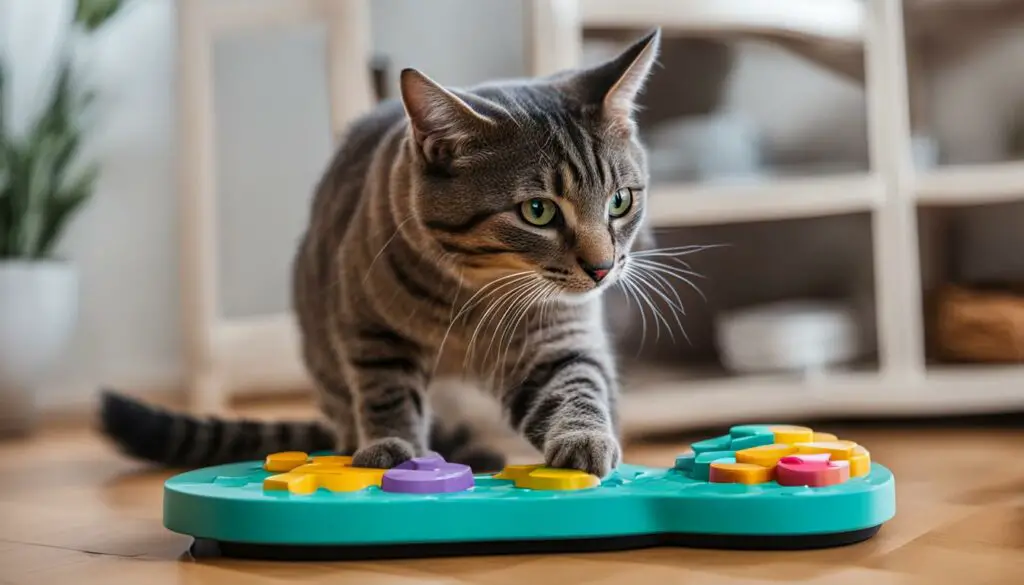
Table: Recommended Interactive Toys for Cats
| Toy Name | Description | Features |
|---|---|---|
| Interactive Treat Puzzle | A puzzle toy that dispenses treats when your cat solves it. | Mental challenge, treat rewards |
| Motion-Activated Toy | A toy that activates and moves on its own, stimulating your cat’s prey instincts. | Motion sensor, random movements |
| Feather Wand | A wand with feathers attached, simulating the movement of prey. | Interactive play, prey-like movements |
| Puzzle Box | A box with hidden compartments and toys for your cat to discover and play with. | Mental challenge, hiding spots |
Establishing Dominance or Masking Scents
Cats have complex social dynamics, and one way they express dominance or establish their territory is through scratching. Your cat may use you as a scratching post to show that they are the dominant one in the household, especially if you have multiple pets. By scratching on you, they leave their scent behind, marking you as their property and asserting their dominance.
Another reason your cat may scratch you is to mask unfamiliar scents that make them feel uneasy. Cats have a highly developed sense of smell, and they may use their own scent to mask the scent of unfamiliar animals or objects. By scratching on you, they are spreading their scent and making themselves feel more secure.
To address this behavior, it’s important to spend quality time with your cat to fulfill their need for attention. Providing enough personal attention and playtime can help reduce their desire to establish dominance through scratching on you. Additionally, you can provide a new scratching post near your favorite chair or change your clothes regularly to redirect their scratching behavior.
“Cats have complex social dynamics, and one way they express dominance or establish their territory is through scratching.”
Table: Cat Dominance Behavior
| Signs of Dominance Behavior | Explanation |
|---|---|
| Scratching on you | By scratching on you, your cat is asserting their dominance and marking their territory. |
| Staring or eye contact | Cats may stare or make intense eye contact to establish dominance over other animals or humans. |
| Blocking your path | If your cat consistently blocks your path or doorways, it can be a sign of asserting dominance. |
| Stealing your seat | Cats may try to take over your favorite spot to establish their dominance and claim it as their own. |
Understanding and addressing your cat’s need to establish dominance or mask scents is essential for promoting a harmonious environment. By providing adequate attention and redirecting their scratching behavior, you can help your cat feel secure without resorting to using you as their personal scratching post.
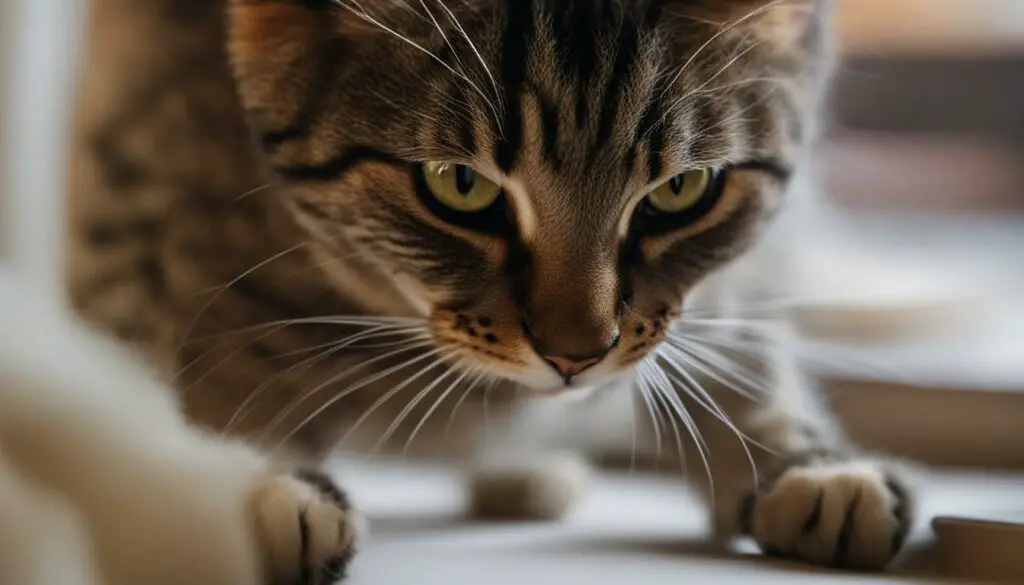
Encouraging Use of a Scratching Post
Teaching your cat to use a scratching post instead of using you as their personal scratching post requires some patience and strategic placement. By making the scratching post enticing and rewarding your cat for using it, you can redirect their scratching behavior in a positive way.
Creating an Appealing Scratching Post
Choose a scratching post that suits your cat’s preferences. Some cats prefer vertical scratching surfaces, while others prefer horizontal ones. Observe your cat’s scratching style to determine the best type of post. Additionally, make sure the scratching post is sturdy and stable to prevent it from toppling over when your cat uses it.
Place the scratching post in a visible and accessible area of your home. Cats are more likely to use a scratching post if it is conveniently located where they spend a lot of time. Consider positioning it near their favorite sleeping spot or close to furniture they previously scratched on. This encourages them to choose the scratching post instead.
Enticing Your Cat to Use the Scratching Post
Make the scratching post more enticing to your cat by attaching toys or treats to it. Dangle a favorite toy above the post or secure a treat dispenser at the top. This creates a positive association with the scratching post and encourages your cat to investigate and use it.
When your cat successfully uses the scratching post, reward them with praise and treats. Positive reinforcement helps reinforce the desired behavior and motivates your cat to continue using the scratching post. Be consistent and persistent in rewarding them when they make the right choice.
| Tip: | Place the scratching post in a visible and accessible location. |
|---|---|
| Use toys or treats to make the scratching post more enticing. | |
| Reward your cat with praise and treats when they use the scratching post. |
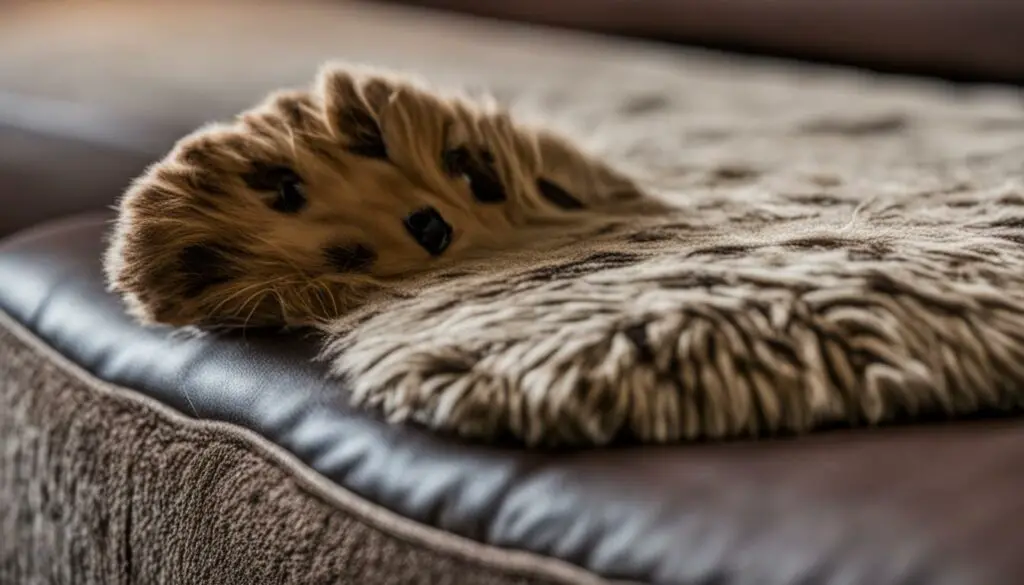
With time and positive reinforcement, your cat will become accustomed to using the scratching post instead of scratching on you. Remember to be patient and consistent in your approach. By redirecting your cat’s scratching behavior, you can create a harmonious environment for both you and your furry friend.
The Importance of Claws for Cats
Claws are vital for cats, serving multiple functions that are essential to their well-being. Understanding the importance of claws can help cat owners appreciate why their pets engage in scratching behavior. Claws provide cats with the ability to defend themselves, climb trees or furniture, maintain balance, and pick up objects. Scratching also helps cats exercise and stretch their muscles, promoting overall physical health.
Furthermore, scratching aids in maintaining healthy claws for cats. The outer sheaths of their nails shed through scratching, allowing new and sharper claws to emerge. This natural process helps keep their claws in proper condition, preventing discomfort and potential issues like ingrown nails.
“Claws are vital for cats, serving multiple functions that are essential to their well-being.”
Cats also scratch to mark their territory. By leaving scent markers through the scent glands in their paws, they establish ownership and communicate boundaries to other animals. Scratching on surfaces, including their owners, allows cats to assert their dominance and claim their territory.
In summary, claws play a vital role in a cat’s life, serving various purposes ranging from self-defense to maintaining physical health. Understanding the significance of claws can help cat owners redirect their pets’ scratching behavior effectively, ensuring a harmonious coexistence between cats and their human companions.
Table: Functions of Cat Claws
| Function | Description |
|---|---|
| Self-defense | Cats use their claws to protect themselves from potential threats and predators. |
| Climbing | Claws enable cats to climb trees, furniture, and other vertical surfaces, satisfying their natural instinct to explore and perch at elevated positions. |
| Balance | By gripping onto surfaces with their claws, cats maintain balance when walking, running, or leaping. |
| Picking up objects | Cats use their claws to grab and manipulate objects, enhancing their hunting and playing abilities. |
| Exercise and muscle stretching | Scratching provides cats with a means to exercise their muscles and stretch, promoting physical health and flexibility. |
| Territorial marking | Scent markers from scratching allow cats to establish ownership and communicate boundaries to other animals. |
Next, we’ll explore the consequences of declawing and alternative ways to address and redirect scratching behavior in cats.
The Consequences of Declawing
Declawing is a controversial procedure that involves the amputation of a cat’s first knuckle. While some cat owners may consider declawing as a solution to prevent their cats from scratching, it is important to understand the significant consequences associated with this procedure.
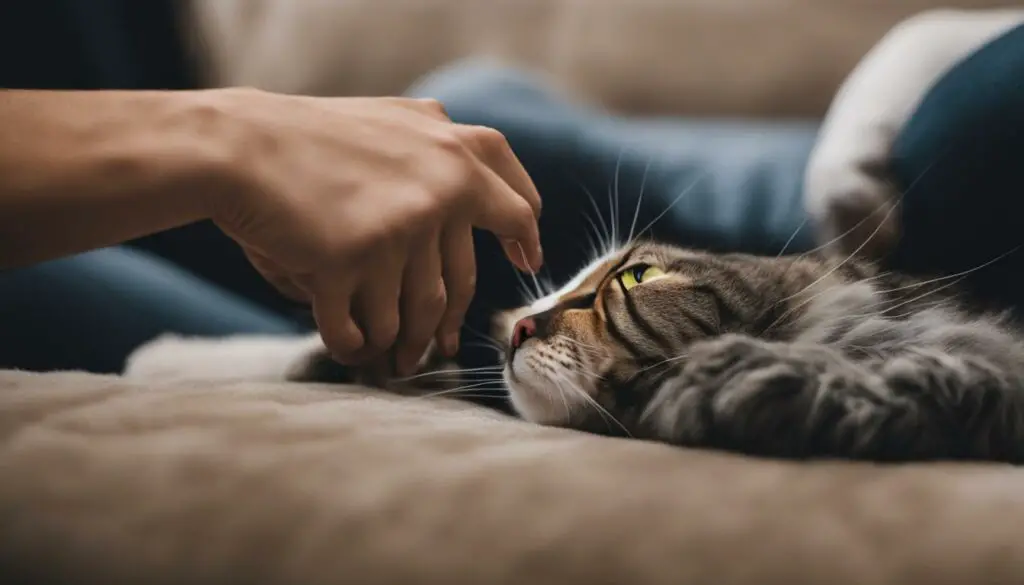
Declawing can lead to both behavioral and physical problems for cats. The removal of their claws can result in chronic pain, difficulty walking, and an increased risk of infection. Declawed cats may also experience behavioral changes, such as increased aggression, inappropriate elimination, and a loss of their natural scratching instincts.
“Declawing is an amputation of a cat’s first knuckle and is a controversial procedure with significant consequences for the cat’s well-being.”
Fortunately, there are humane alternatives to declawing that can help address unwanted scratching behavior without causing harm to your cat. One alternative is providing appropriate scratching surfaces, such as scratching posts or cat trees. These surfaces allow cats to satisfy their natural urge to scratch while keeping their claws intact.
Another alternative is regular nail trimming. By trimming your cat’s claws, you can effectively reduce the risk of scratches without resorting to declawing. It is important to learn the proper technique for nail trimming or seek assistance from a veterinarian.
| Consequences of Declawing | Alternatives to Declawing |
|---|---|
| Chronic pain | Providing appropriate scratching surfaces |
| Difficulty walking | Regular nail trimming |
| Increased risk of infection | Scratching deterrent sprays |
| Behavioral changes | Soft nail caps |
Redirecting Scratching Behavior
If your cat has a habit of using you as a scratching post, it’s important to redirect their behavior to protect yourself and promote their well-being. One effective way to achieve this is by encouraging the use of scratching posts.
Scratching posts provide a designated area for your cat to satisfy their scratching instincts. When choosing a scratching post, consider your cat’s preferred scratching style. Some cats prefer vertical scratching, while others lean towards horizontal scratching. Providing the appropriate type of scratching post will increase the likelihood of your cat using it.
Encouraging Use of a Scratching Post
To encourage your cat to use the scratching post, place it in a visible and accessible location. An ideal placement is near the areas where your cat frequently scratches on you. Additionally, make the scratching post enticing by attaching fun toys or treats to it. This will help your cat associate positive experiences with the scratching post and increase their motivation to use it.
Furthermore, positive reinforcement plays a crucial role in redirecting your cat’s scratching behavior. When you catch your cat using the scratching post, praise them and offer treats as rewards. This will reinforce the desired behavior and make them more likely to continue using the scratching post.
Alternatives to Scratching Posts
If your cat is still resistant to using a scratching post, there are alternative options you can explore. Some cats prefer other surfaces such as cardboard scratching pads or sisal mats. Experiment with different materials and textures to find what your cat prefers.
In addition, providing a variety of scratching surfaces throughout your home can help redirect your cat’s scratching behavior. This can include vertical and horizontal scratching options, as well as different materials and heights. By offering a range of choices, you increase the chances of finding a surface that your cat finds appealing and satisfies their scratching needs.
Redirecting your cat’s scratching behavior requires patience and consistency. By providing appropriate scratching surfaces, using positive reinforcement, and exploring alternative options, you can successfully steer your cat away from using you as their personal scratching post.
Ensuring Mental Stimulation
Keeping your cat mentally stimulated is essential for their overall well-being and can help prevent destructive scratching behavior. Cats are intelligent and curious creatures, so engaging their minds with interactive toys and environmental enrichment is crucial.
Interactive toys are a great way to provide mental stimulation for your cat. Toys that require problem-solving, such as puzzle toys that dispense treats, can keep your cat entertained and mentally engaged. These toys tap into their natural hunting instincts and provide a rewarding challenge.
Environmental enrichment is another important aspect of ensuring mental stimulation for your cat. Creating a stimulating environment can be as simple as providing hiding spots, vertical spaces, and scratching surfaces throughout your home. Cats enjoy exploring and using their natural climbing abilities, so cat trees and shelves can offer opportunities for physical exercise and mental engagement.
Remember to rotate your cat’s toys and rearrange their environment periodically to keep things fresh and exciting. This will prevent your cat from getting bored and reduce the likelihood of them using you as a scratching post.
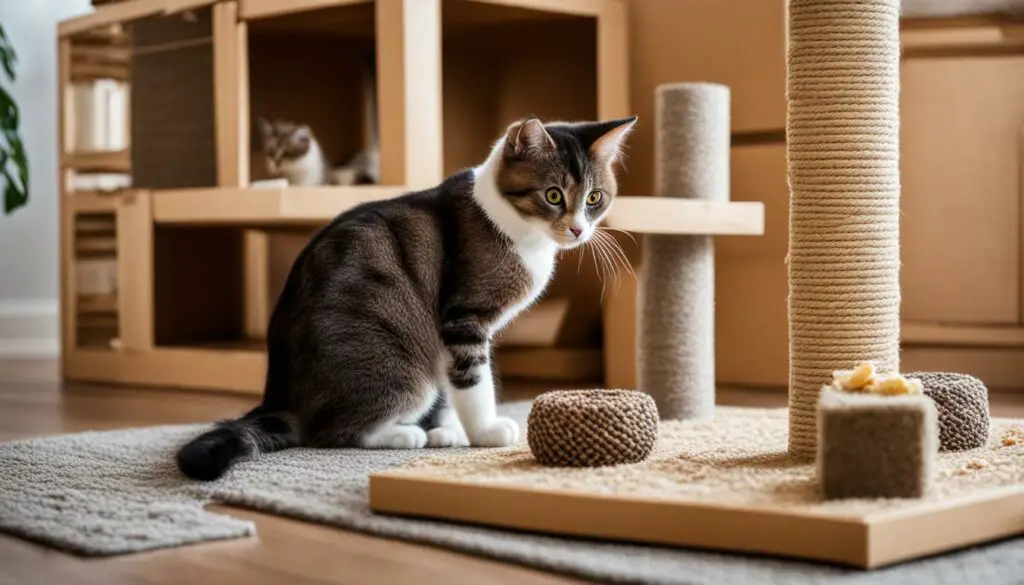
Benefits of Mental Stimulation for Cats
Mental stimulation provides numerous benefits for cats. It helps prevent boredom and the resulting destructive behavior, such as scratching furniture or using you as a scratching post. Engaging your cat’s mind can also improve their overall mood and reduce stress and anxiety.
Additionally, mental stimulation through interactive play and environmental enrichment helps keep your cat physically active, which is vital for their health and well-being. Regular mental and physical exercise can prevent obesity, muscle stiffness, and other health issues in cats.
By ensuring that your cat receives sufficient mental stimulation, you can help create a happy and contented feline companion. Remember to provide a variety of interactive toys, enrich their environment, and spend quality time engaging in play with your cat.
The Joy of Scratching for Cats
Scratching is an innate behavior for cats, and it serves several important purposes in their lives. By understanding the benefits and importance of scratching for cats, we can better appreciate and address their scratching behavior.
One of the key benefits of scratching is that it allows cats to exercise their muscles and keep them strong and healthy. When a cat scratches, they engage multiple muscle groups, including their shoulders, back, and legs. This stretching and flexing helps to maintain their overall physical well-being.
Additionally, scratching is essential for maintaining healthy claws. When cats scratch, they shed the outer layers of their nails, which helps to keep them sharp and prevents them from becoming too long or overgrown. It also allows cats to remove any dirt or debris that may have accumulated in their claws.
Scratching also serves as a form of emotional and territorial communication for cats. By scratching on objects or surfaces, they leave behind their scent, signaling to other cats that the area is claimed and establishing their presence. This behavior helps cats feel secure and confident in their environment.
| Benefits of Scratching for Cats | Importance of Scratching for Cats |
|---|---|
| Exercise for muscles | Maintaining healthy claws |
| Stretching and flexing | Emotional and territorial communication |
| Physical well-being | Security and confidence |
Understanding the joy and satisfaction that scratching brings to cats can help us approach their scratching behavior with a positive mindset. Instead of viewing it as destructive or problematic, we can provide appropriate outlets for their natural instincts, such as providing scratching posts or designated areas for them to scratch. By doing so, we can ensure that both our cats and our furniture can coexist harmoniously.
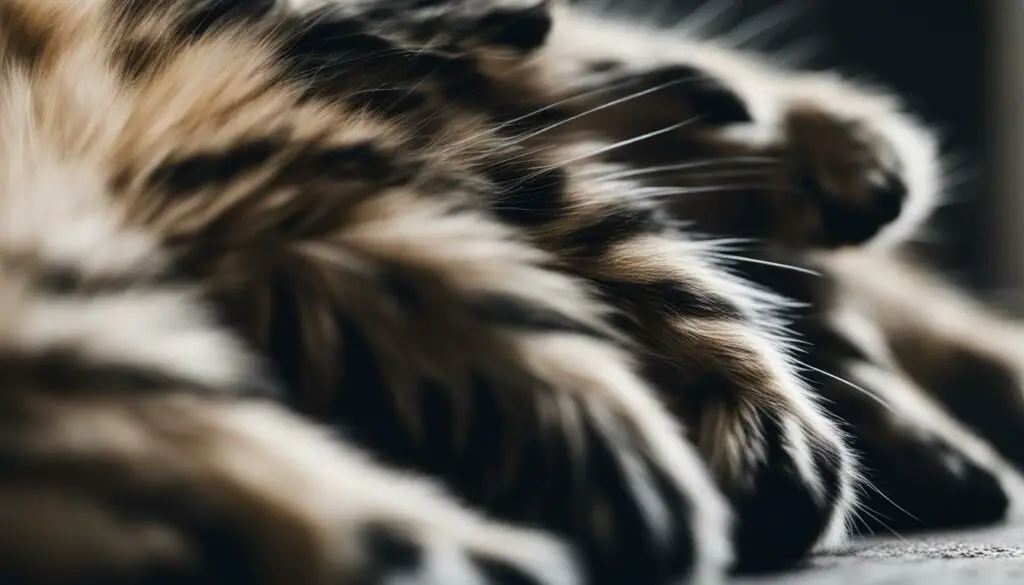
Scratching Solutions
- Provide multiple scratching surfaces, such as scratching posts and cat trees, to give your cat options.
- Place scratching posts near areas where your cat frequently scratches, redirecting their behavior.
- Trim your cat’s nails regularly to help minimize any potential damage from scratching.
- Engage in interactive play sessions with your cat to provide mental and physical stimulation.
- Use positive reinforcement, such as treats and praise, to encourage your cat to use appropriate scratching surfaces.
“A happy and satisfied cat is one that has the opportunity to engage in their natural scratching behavior.”
Conclusion
Understanding your cat’s scratching behavior and finding ways to redirect it is crucial for a harmonious relationship with your furry friend. By addressing the underlying reasons behind their choice to use you as a scratching post, you can effectively guide them towards more appropriate alternatives. Remember, your cat’s scratching is a natural instinct, and with patience and understanding, you can redirect their behavior without compromising their well-being.
To redirect your cat’s scratching behavior, provide them with alternative scratching surfaces such as scratching posts or cat trees. Place these surfaces in visible and accessible locations, near areas where they frequently scratch on you. Encourage their use by attaching fun toys or treats to the scratching surfaces and rewarding them with praise and treats when they use them.
Mental stimulation is also essential in preventing boredom and destructive scratching behavior. Engage your cat in playtime with interactive toys and provide environmental enrichment, such as puzzle toys and hiding spots. Keeping their mind stimulated will reduce the likelihood of them using you as a scratching post.
Lastly, remember that understanding your cat’s instincts and needs is key to addressing their scratching behavior. Cats scratch for various reasons, including marking territory, relieving stress, and maintaining healthy claws. By providing appropriate outlets for their natural scratching behaviors, redirecting their attention, and ensuring mental stimulation, you can save yourself from being their personal scratching post and foster a happier, scratch-free environment for both you and your feline companion.
FAQ
Why does my cat use me as a scratching post?
Cats have a natural instinct to scratch, and using you as a scratching post may be a way for them to mark their territory or seek comfort and security. Understanding the reasons behind this behavior can help you address and redirect it appropriately.
How can I train my cat not to scratch me?
To discourage your cat from using you as a scratching post, you can train them to get down when they start scratching on your body. Use a firm “No. Get down” command to redirect their behavior. Consistency is key in training cats.
Should I trim my cat’s claws?
Regularly trimming your cat’s nails can help prevent them from scratching you. It also promotes healthy nail growth. Cats’ nails grow in layers, and scratching is necessary for shedding the outer sheaths of the nails.
How can I redirect my cat’s scratching behavior?
Providing your cat with alternative surfaces for scratching, such as a scratching post or cat tree, can help redirect their scratching behavior. Place the scratching post near areas where your cat frequently scratches on you to encourage them to use it instead.
How can I prevent my cat from getting bored and scratching me?
Ensuring your cat receives adequate mental stimulation is important to prevent boredom and destructive scratching behavior. Engage in playtime and provide interactive toys, such as treat-dispensing puzzle toys, to keep your cat entertained and mentally stimulated.
Why does my cat scratch me when I have other pets?
Cats may scratch you as a way to establish dominance over another pet or to mask the scent of something that makes them feel uneasy. Spend more personal time with your cat if you have multiple pets to address their need for attention.
How can I encourage my cat to use a scratching post?
Place the scratching post in a visible and accessible location. Attach fun toys or treats to the post to make it more enticing. Reward your cat with praise and treats when they use the scratching post.
Should I declaw my cat?
Declawing is a controversial procedure with significant consequences for the cat’s well-being. It can lead to behavioral and physical problems. It’s essential to explore alternatives to declawing, such as providing appropriate scratching surfaces, to maintain your cat’s health and happiness.
How can I redirect my cat’s scratching behavior?
Redirecting your cat’s scratching behavior involves providing them with appropriate scratching surfaces, such as scratching posts. Understanding your cat’s preferred scratching style, whether vertical or horizontal, can help you choose the right type of scratching post.
How can I keep my cat mentally stimulated?
Engage your cat in playtime using interactive toys and provide environmental enrichment, such as puzzle toys and hiding spots. Keeping your cat’s mind stimulated will help alleviate boredom and reduce the likelihood of them using you as a scratching post.
Why do cats scratch?
Scratching is a natural and instinctual behavior for cats. It provides various benefits, such as muscle exercise, stretching, and maintenance of healthy claws. Understanding the joy and satisfaction that scratching brings to cats can help you approach their scratching behavior with a positive mindset.
Source Links
- https://www.hepper.com/why-does-cat-use-me-as-scratching-post/
- https://petkeen.com/why-does-cat-use-me-as-scratching-post/
- https://www.reddit.com/r/rescuecats/comments/8tv4s5/guide_why_cats_scratch_and_why_is_it_important_to/

